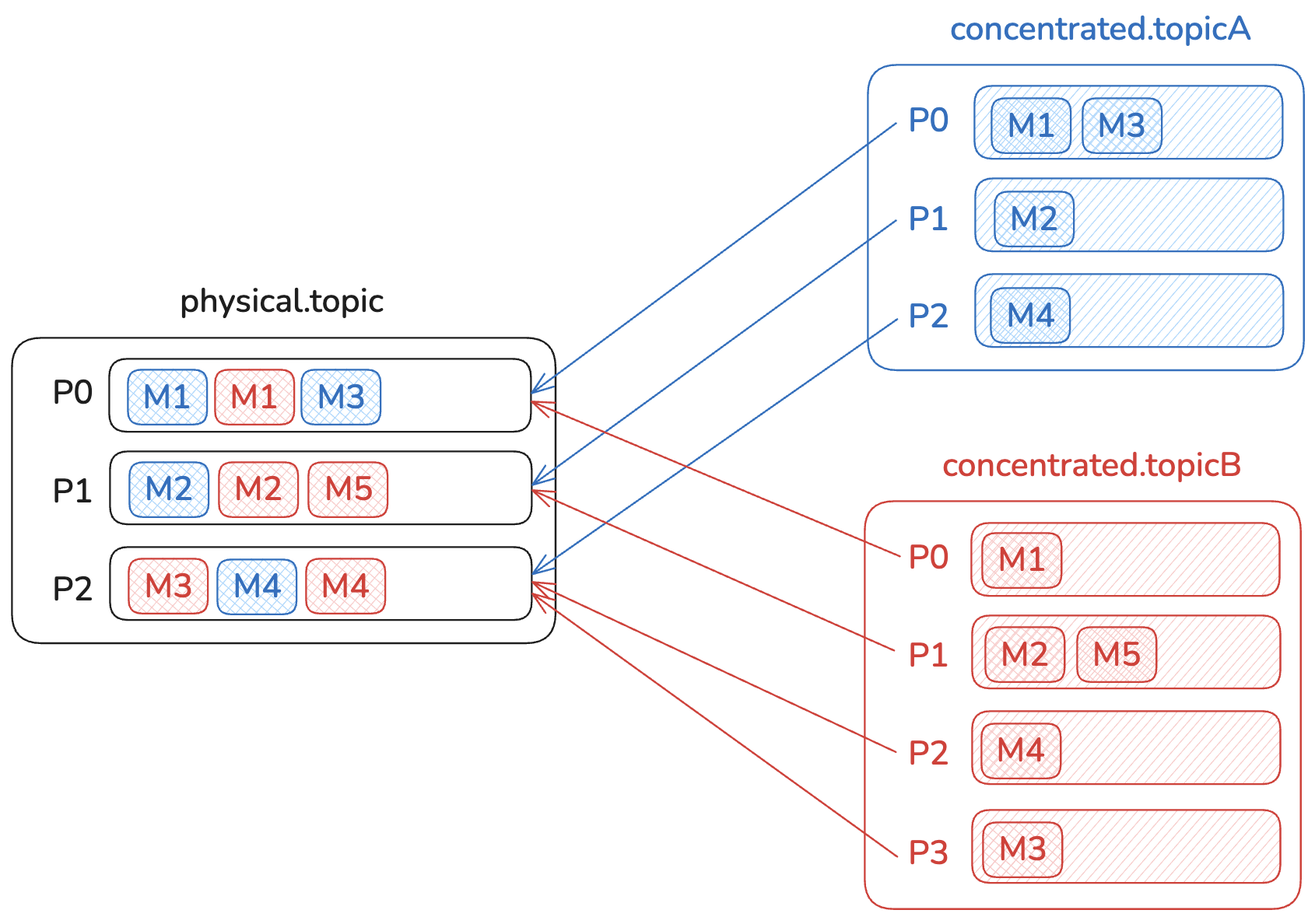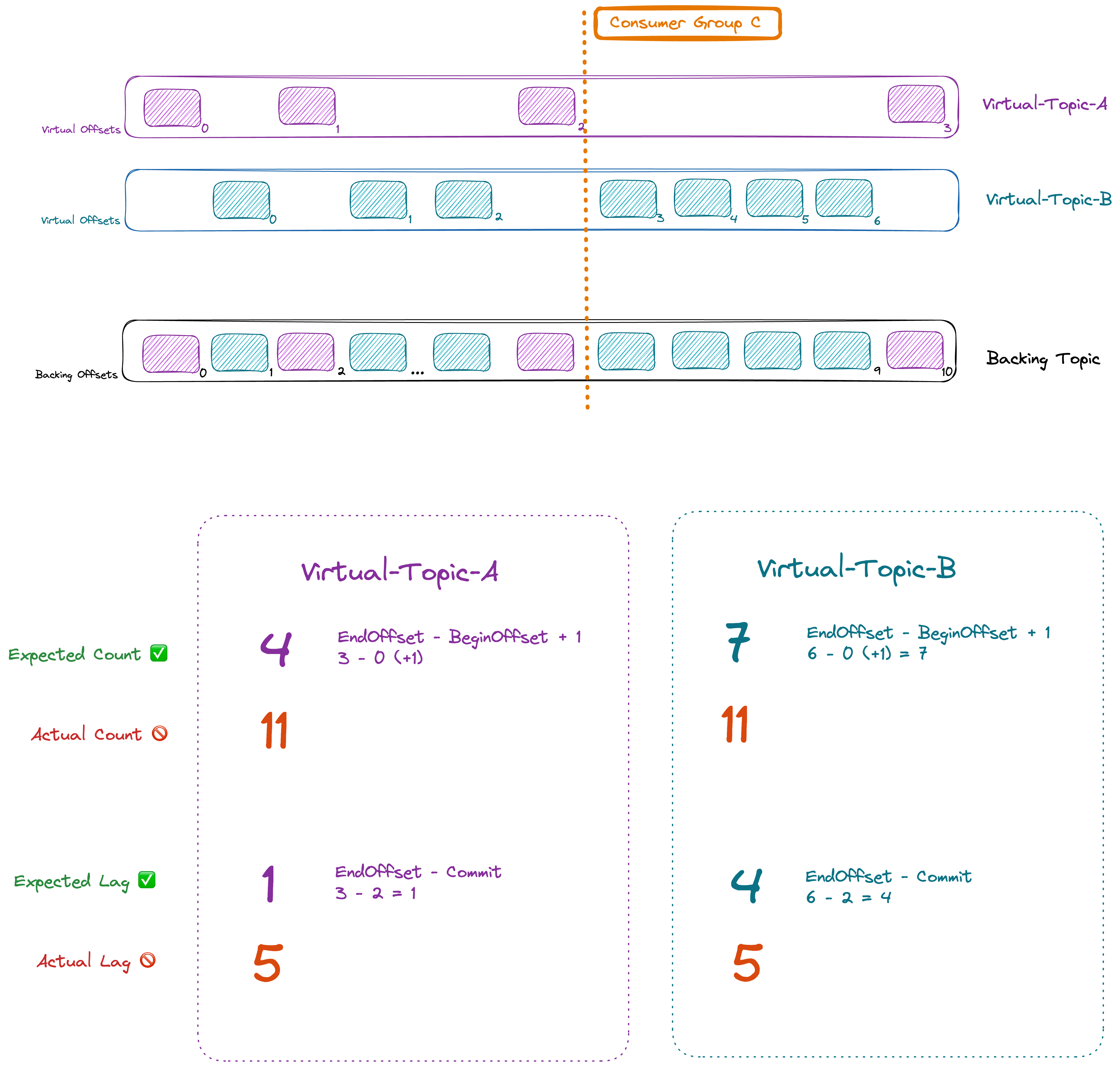Concentrated Topics
Concentrated Topics transparently act as pointers to a single physical topic on your Kafka cluster. They allow you to reduce costs on low-volume topics by co-locating messages. They are completely transparent to consumers and producers and allow you to emulate different partition counts irrespective of the backing physical topic's partition count.
Usage
As per the Gateway API documentation, you can create a concentration rule to concentrate topics based on a prefix.
The following API call is an example that will set a rule to modify any new topics created with the prefix concentrated. to be concentrated topics:
curl \
--request PUT \
--url 'http://localhost:8888/gateway/v2/concentration-rule' \
--user 'admin:conduktor' \
--header 'Content-Type: application/json' \
--data-raw '{
"kind": "ConcentrationRule",
"apiVersion": "gateway/v2",
"metadata": {
"name": "concentrationRule1",
"vCluster": "passthrough"
},
"spec": {
"pattern": "concentrated.*",
"physicalTopics": {
"delete": "physical.topic.delete",
"compact": "physical.topic.compact",
"deleteCompact": "physical.topic.deleteCompact"
},
"autoManaged": true
}
}'
In this configuration, you can provide 3 physicalTopics, based on their cleanup policy. Each will store the messages of concentrated topics matching their cleanup policy.
The autoManaged flag, when enabled, will automatically create the physical topics with the default configuration of the physical cluster and the default number of partitions (num.partitions).
In the autoManaged mode, topics created by users will auto-extend the configuration (for example to honour the request retention.ms). As a result, if one users asks for a compacted topic with a retention of -1 (infinite), all other compacted topics associated with the concentration rule are now with infinite retention.
You can now create a concentrated topic by matching the pattern mentioned in your concentration rule.
kafka-topics \
--bootstrap-server conduktor-gateway:6969 \
--topic concentrated.topicA \
--partitions 10
How does it work?
When you create a concentrated topic, each concentrated partition is mapped to a physical partition, as shown below:

In this case, we have 2 concentrated topics (concentrated.topicA & concentrated.topicB), with partition counts of 3 and 4 respectively, that are mapped to a single physical topic (physical.topic) with 3 partitions.
To ensure that consumers don't consume messages from other partitions or from other concentrated topics, we store the concentrated partition and the concentrated topic name in the record headers. Gateway will automatically filter the messages that should be returned to the consumer.
Compact Cleanup Policy
In the case of a compact cleanup policy, we should not force two records produced into two different concentrated topics with the same key to be stored in the same partition.
For that, the Gateway will add an identifier for each concentrated compacted topic as a key suffix. You can find this suffix in the internal topic that stores all the topic mappings.
This suffix is invisible for applications and is removed on consumption.
In this internal topic, you can see how concentrated and physical partitions are mapped together!
Limitations
Configuration
The following list of topic properties are the only allowed properties for concentrated topics:
partitionscleanup.policyretention.msretention.bytesdelete.retention.ms
If any other configuration besides the above is being set, and is different from the physical cluster default, the topic creation will fail with an error:
Configuration is invalid.
If autoManaged is disabled, the retention.ms and retention.bytes values must not exceed the physical topic's configuration. Otherwise, the topic creation will fail with an error like the one below:
Error while executing topic command : Value '704800000' for configuration 'retention.ms' is incompatible with physical topic value '604800000'.
With concentrated topics, the enforced retention policy is the physical topic's retention policy, and not the policy requested at the concentrated topic creation time.
retention.ms and retention.bytes are not cleanup guarantees. They are retention guarantees.
Performance
Gateway must read all the messages for all the consumers and skip the ones that are not necessary for each consumer.
Message Count & Lag, Offset (in)correctness
Concentrated topics & SQL topics are virtualised, which creates incompatibilities with existing tools in the Kafka Ecosystem (Conduktor included) that rely on topics metadata to generate reports, graphs or calculations.
Right now, the 2 most problematic calculations are Lag and Message Count. This is due to the calculation method that rely on partition EndOffset.

Any tooling will currently display the message count, and the lag relative to the EndOffset, of the physical topic. This can create confusion for customers and applications that will see wrong metrics.
We are working to address that limitation in the near-future. Contact us to get more information.